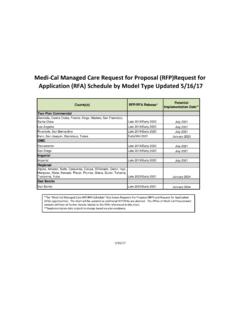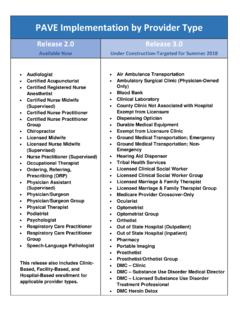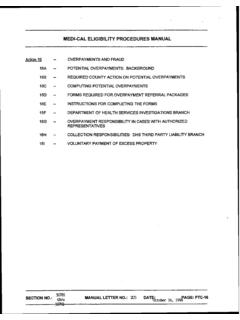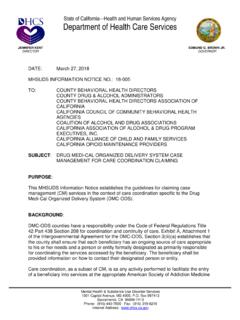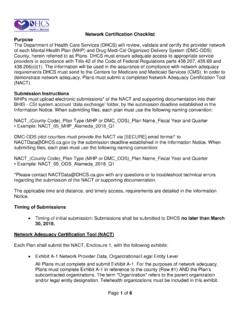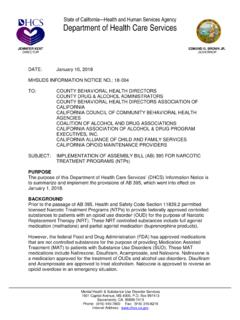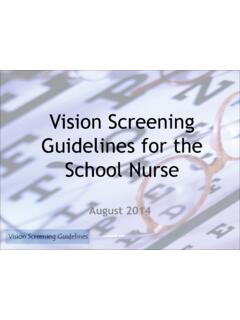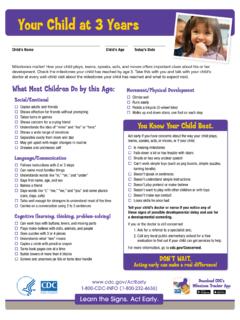Transcription of CHDP Pediatric Vision Screening - California
1 7/14/20171 chdp Pediatric Vision ScreeningChild Health and Disability Prevention ( chdp ) ProgramSystems of Care Division (SCD) California Department of Health Care ServicesLearning Objectives Understand the importance of Vision Screening during childhood. Become aware of eye problems that affect Vision . Describe and implement the chdp program guidelines for referral and follow-up. Identify the steps of Vision Screening and document Perform Vision Screening ? Recommended as part of the American Academy of Pediatrics Bright Futures Periodicity Schedule For ages where risk assessment is required, see Bright Futures Pre-visit Questionnaire Available in all ages7/14/20174 Bright Futures Pre-Visit Questionnaire for 7-year-old7/14/20175 Why Perform Vision Screening ? Primary Care Physicians and Nurses: The first line of defense to detect preventable Vision loss in childrenEarly detection of amblyopia - lazy eye Leading cause of Vision loss among children7/14/20176 Amblyopia Amblyopia is the leading cause of Vision loss among children.
2 Eyes and brain are not working together. One eye sees a blurred view and the other a normal view. The brain only processes the normal can only develop during childhood. If not treated in childhood, amblyopia may result in permanent Vision loss. The most common cause of Vision loss in adults 20-70 years of age is untreated childhood Common causes are: Untreated or unequal refractive errors (nearsighted, farsighted, astigmatism)Strabismus crossed eyes Obstruction ( ptosis, cataract)Common Causes of Amblyopia1. Types of refractive nearsighted : does not see objects well at far distances7/14/201797/14/201710 Common Causes of Amblyopia1. Typesof refractive errorsb. Hyperopia farsighted : does not see objects well at close distances7/14/201711 Common Causes of of refractive : an irregular curve in the eye causing blurry Vision at all distances Common Causes of Amblyopia2. Strabismus crossed eyes : misalignment of the eyes May have double Vision One or both eyes turning inward One or both eyes turning outward One eye turning up or down7/14/201712 Common Causes of Amblyopia3.
3 : drooping of an eyelid due to a weak lid muscle. May obstruct Vision Look for chin elevation in these Causes of Amblyopia3. Obstructionb. Cataract: condition in which the lens of the eye becomes progressively cloudy, resulting in blurred Early is Best School-aged Vision Screening may be too late. Amblyopia is harder to treat after 5 years of age. By 7 years of age, some Vision loss from amblyopia may become Screening in the United StatesNational Eye Institute (NEI) Amblyopia affects 2-3% of children in the United States. About million children with preventable Vision to Screening Poor cooperation of young children Takes time to perform Staff not adequately trained Poor reimbursement for physicians7/14/201718 Visual Acuity Screening GuidelinesAmerican Academy of Pediatrics Policy StatementPediatricsJanuary 2016 Screening with a tool such as a photoscreeneris recommended for children 12 months of age and older unlessthey can reliably perform visual acuity Screening with eye charts.
4 Visual acuity Screening using eye charts remains the gold standard. It can begin as early as 3 years of to 35 Months (0-3 years)Procedures for the Evaluation of the Visual SystemPediatricsJanuary 2016 Take a health history: Are there eye problems inclose relatives? Check Vision (tracking), eye movement (motility)and alignment (strabismus) Check pupils and red reflexes (round, equal,bright)NOTE: This assessment can also be done on older children of any age with developmental 3 through 5 yearsRecommended Chart TypesLEA SymbolsHOTV Letters7/14/201722 Ages 3 through 5 yearsRecommended Chart Types7/14/201723 Age-Dependent Pass/Fail Guidelines New AAP guidelines 3 years old: the critical line to pass Screening is the 20/50line. 4 years old: the critical line to pass Screening is the 20/40line. 5 years and older: the critical line to pass Screening is the 20/32line for Sloan and LEA/HOTV (or 20/30 in Snellen chart).7/14/20172436 to 47 Months (3 years) Must be able to identify the majority of the 20/50 line with each eye.
5 Screening is typically done at 10 feet. Opposite eye must be fully to 59 Months (4 years) Must be able to identify the majority of the 20/40 line with each eye. Screening is typically done at 10 feet. Opposite eye must be fully Months and Older (5+ years) Must be able to identify the majority ofthe 20/32 line (or 20/30 in Snellenchart) with each eye. Use LEA symbols, HOTV letters forchildren who do not know their letters. Use Sloan letters for children who knowtheir letters. Preferred over Snellen letters chart Snellen letters chart have a 20/30 line Recommended Screening distance is 10-feet using a 10-foot chart. Fully cover opposite eye. Repeat Screening every 1-2 years. Risk assessment should be done whenscreening is not Months and Older (5+ years) FOR Screening AT 10 FEET7/14/20172860 Months and Older (5+ years) Sloan Letters Chart Preferred over Snellen Association for Pediatric Ophthalmology and Strabismus (AAPOS) Vision Screening Kit Acuity charts for threshold or critical line Screening : Sloan letters LEA symbols or HOTV letters Occluder patches/glasses/paddle 10 foot measuring cord Matching response card Informational DVDsThresholdCritical Line7/14/201730 Threshold and Critical Line Options7/14/201731 Threshold Screening Reading down the eye chart as far as possible.
6 Threshold line is the smallest line child can pass. Can identify 2-line difference between the Line Screening : FASTER Only read a single critical line with each eye. Each chart has two boxed critical lines - one for each eye. The top line of large optotypes (symbols/letters) is for practice before starting Screening . 7/14/201733 Vision Screening Charts Not Recommended7/14/201734 Occlusion of Non-tested Eye Adhesive patches are best. For all Screening methods, completely cover the eye not being screened to prevent Recommended7/14/201735 Only for age 10 years and older7/14/201736 Key Points Use eye charts with lines of optotypes or matching cards with lines (crowding bars) around each optotype to obtain the most accurate visual acuity assessment. Crowding bars around the optotype make individual symbols/letters more difficult to identify when amblyopia is present. 7/14/201737 Key Points Screening line marked at 10 (or 20)-feet on the line is directly in front of eye Screening area Out of traffic area Have adequate lightingSCREENING LINESCREENING LINE10 or 20 FEET7/14/201738 Key Points Eye chart should be at child s eye level.
7 Each eye should be screened separately (monocularly). Either critical line or threshold Screening may be with the following disorders should bypass Screening and should be referred directly to an eye specialist:Automatic Referral for Eye eye disorders ( strabismus, ptosis) neurodevelopmental disorders: Hearing impairment Motor abnormalities ( cerebral palsy) Down Syndrome Cognitive impairment Autism spectrum disorder Speech delay7/14/201740 Automatic Referral for Eye diseases present ( diabetes, sickle cell disease, hypertension) medications known to cause eye disorders ( some anti-depressants and steroids) relative with strabismus or : less than 32 weeks of believes child has Vision problem7/14/201741 New AAP Guidelines:Age-Dependent Referral Criteria 3 years old: Missing 3 or more symbols on the 20/50 line, or any line above the 20/50 line, with either eye 4 years old: Missing 3 or more symbols on the 20/40 line, or any line above the 20/40 line, with either eye 5 years and older.
8 Missing 3 or more symbols on the 20/32 (20/30) line, or any line above the 20/32 (20/30) line, with either eye Two line difference between the eyes, even within the passing range ( 20/20 and 20/32)42 Follow-Up Maintain referral log to track status of referral. Follow-up with parent/guardian as Children If child is unable to cooperate during the Screening , make a second attempt the same day ( later during the same visit). If same day rescreening is not possible, reschedule as soon as possible, but no later than 6 months. Schedule follow up appointment prior to the patient leaving provider office. If you cannot screen a child, then refer to an ophthalmologist or optometrist experienced in the care of children for an eye Vision Screening Certification Requirements Screeners must attend Vision Screening Training led by chdp staff (or another agency approved by local chdp ). Renew certification every four Vision Screening Instrument-based Screening is the process of using an instrument such as a photoscreener, autorefractoror other device, to screen for risk factors for Vision problems.
9 Doesnot replace visual acuity Screening with eye charts. Endorsed by American Academy of Pediatrics (AAP).7/14/201746 Instrument Screening is Useful For: All children ages 1-3 years Usually unable to perform visual acuity Screening Some children ages 3-5 years Acuity chart Screening is preferred, Instrument-based Screening is an acceptable alternative. Older children who are non-verbal, developmentally delayed or otherwise unable to perform Screening with acuity is the Difference Between Vision Screening with Eye Charts and Vision Screening with Devices? Vision Screening with eye charts measurethe actual visual acuity ( 20/20). Vision Screening devices DO NOTmeasure visual acuity directly. Screening instruments test for eye conditionsor risk factors that are known to causedecreased Vision or Vision Screening InstrumentsWelch Allyn SureSightRighton RetinomaxiScreenPlusOptixS12 RWelch Allyn Spot 7/14/201749 Acknowledgments These guidelines are based on recommendations from the American Academy of Pediatrics (AAP) and the National Expert Panel of the National Center for Children s Vision and Eye Health (NCCVEH) at Prevent Blindness.
10 These slides have been adapted from the American Association for Pediatric Ophthalmology and Strabismus (AAPOS) with their permission. Visual System Assessment in Infants, Children and Young Adults by Pediatricians American Academy of Pediatrics Policy Statement Pediatrics. January 2016. Volume 137. Issue 1 Procedures for the Evaluation of the Visual System by Pediatricians American Academy of Pediatrics Clinical Report Pediatrics. January 2016. Volume 137. Issue 17/14/201750 References and LinksReferences and Links Bright Future and Preventative Medicine Coding Fact Sheet American Academy of Pediatrics Professional Resources Practice Transformation Coding at the AAP Updated January 2016 Vision Screening for Children 36 to < 72 Months: Recommended Practices National Expert Panel to the National Center for Children s Vision and Eye Health Optometry and Vision Science. January 2015. Volume 92. No. 1 chdp 2016 Vision Health Assessment Guidelines 7/14/201751


